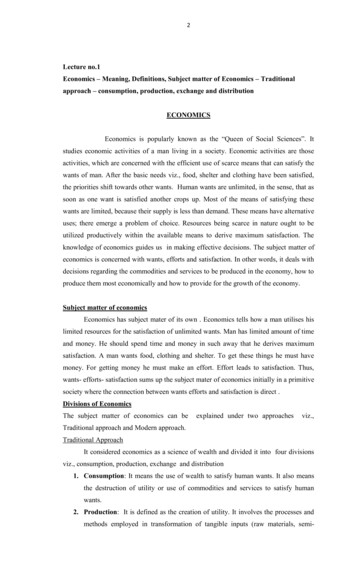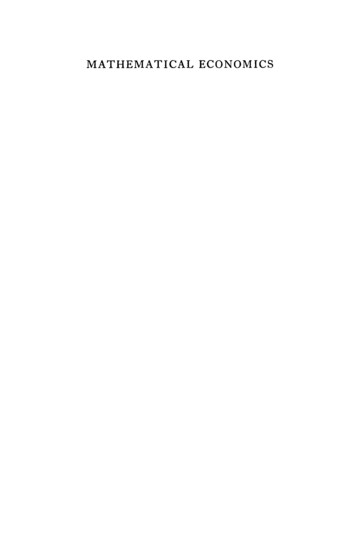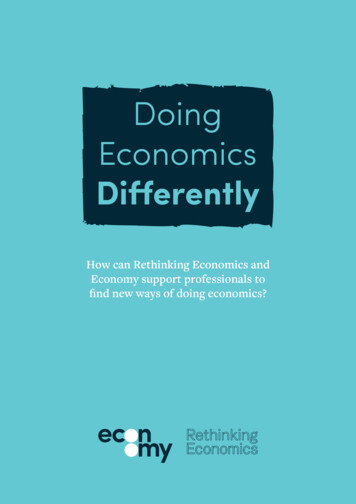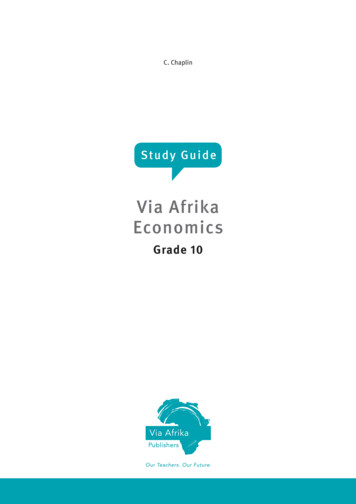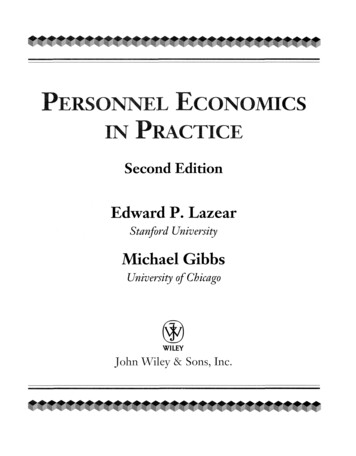
Transcription
PERSONNEL ECONOMICSIN PRACTICESecond EditionEdward P. LazearStanford UniversityMichael GibbsUniversity of ChicagoWILEYJohn Wiley & Sons, Inc.
CONTENTSABOUT THE AUTHORSPREFACEACKNOWLEDGMENTSviiixxvPART O N ESORTING AND INVESTING IN EMPLOYEES1CHAPTER 1SETTING HIRING STANDARDSAn Example: Hiring Risky WorkersNew Hires as OptionsAnalysisA CounterargumentSetting Hiring StandardsBalancing Benefits Against CostsForeign CompetitionThe Method of ProductionHow Many Workers to Hire?Other FactorsMaking Decisions with Imperfect InformationMake a Decision Independent ofAnalysisEstimate the Relevant InformationExperimentSummaryStudy QuestionsReferencesFurther HAPTER 2RECRUITMENTIntroductionScreening Job ApplicantsCredentialsLearning a Worker's ProductivityIs Screening Profitable? For Whom?Probation25252627283132XIX
xx ContentsSignalingWho Pays, and Who Benefits?ExamplesSignaling More Formally: Separating and PoolingEquilibriaWhich Type of Firm is More Likely to use Signaling?SummaryStudy QuestionsReferencesFurther ReadingAppendix33363738404042424343CHAPTER 3INVESTMENT IN SKILLSIntroductionMatchingInvestments in EducationEffects of Costs and BenefitsWas Benjamin Franklin Correct?Investments in On the Job TrainingGeneral vs. Firm-Specific Human CapitalWho Should Pay for Training?Implications of On the Job TrainingRent Sharing and CompensationImplicit ContractingSummaryStudy QuestionsReferencesFurther HAPTER 4MANAGING TURNOVERIntroductionIs Turnover Good or Bad?Importance of SortingTechnical ChangeOrganizational ChangeHierarchical StructureSpecific Human CapitalRetention StrategiesReducing Costs ofLosing Key EmployeesEmbracing TurnoverBidding for EmployeesRaiding Other Firms: Benefits and PitfallsOffer Matching8181818283838484848788898993
ContentsLayoffs and BuyoutsWho to Target for LayoffsBuyoutsSummaryStudy QuestionsReferencesFurther ReadingAppendix xxi969699104105105106106PART T w oORGANIZATIONAL AND J O B DESIGN107CHAPTERSDECISIONMAKINGIntroductionThe Organization of an EconomyMarkets as Information SystemsMarkets as Incentive SystemsMarkets and InnovationBenefits of Central PlanningThe Market as Metaphor for Organizational DesignBenefits of CentralizationEconomies of Scale or Public GoodsBetter Use of Central KnowledgeCoordinationBenefits of DecentralizationSpecific vs. General KnowledgeOther Benefits of DecentralizationAuthority and ResponsibilityDecision Making as a Multistage ProcessFlat vs. Hierarchical StructuresInvesting in Better Quality Decision MakingSummaryStudy QuestionsReferencesFurther 8120120122123124126133136138138139139CHAPTER 6ORGANIZATIONAL STRUCTUREIntroductionTypes of Organizational StructuresHierarchyFunctional StructureDivisional StructureMatrix or Project StructureNetwork Structure143143145145147148153155
xxii ContentsWhich Structure Should a Firm Use?CoordinationTwo Types of Coordination ProblemsCoordination MechanismsImpl ementationSpan of Control and Number of Levels in a HierarchySkills, Pay, and StructureEvolution of a Firm 's StructureSummaryStudy QuestionsReferencesFurther ReadingCHAPTER 7CHAPTER 8157158158160163163166167168170170171JOB DESIGNIntroductionPatterns of Job DesignOptimal Job Design: Skills, Tasks, and DecisionsMultiskilling and MultitaskingDecisionsComplementarity and Job DesignWhen to Use Different Job DesignsTaylorismFactors Pushing Toward Taylorism or ContinuousImprovementIntrinsic MotivationSummaryStudy QuestionsReferencesFurther ReadingAppendix173173174177111183184186186ADVANCED JOB DESIGNIntroductionTeamsGroup Decision MakingFree Rider EffectsWhen to Use TeamsOther Benefits of Team ProductionImplementation of TeamsTeam CompositionWorker- Owned FirmsEffects of Information TechnologyEffects on Organizational StructureEffects on Job Design2 197198198
ContentsHigh Reliability OrganizationsSummaryStudy QuestionsReferencesFurther ReadingAppendix xxiii222224226226227227PART T H R E EPAYING FOR PERFORMANCE231CHAPTER 9PERFORMANCE EVALUATION237IntroductionPurposes of Performance EvaluationWays to Evaluate PerformanceQuantitative Performance MeasurementRisk ProfileRisk vs. Distortion: Performance Measure ScopeMatch of the Performance Measure to Job DesignManipulationSubjective EvaluationWhy Use Subjective Evaluations?The Benefits of Subjective EvaluationsPractical ConsiderationsSummaryStudy QuestionsReferencesFurther ReadingCHAPTER 10REWARDING PERFORMANCEIntroductionHow Strong Should Incentives Be?IntuitionImperfect Evaluations and Optimal IncentivesSummary: How Strong Should Incentives Be?Paying for Performance: Common ExamplesRewards or Penalties?Lump Sums, Demotions, or PromotionsCaps on RewardsApplicationsProfit Sharing and ESOPsOrganizational Form and ContractingMotivating 5825925926126126426426927227321Ъ2762782802802822 84
xxiv ContentsSummaryStudy QuestionsReferencesFurther ReadingAppendix285286287287287CHAPTER 11CAREER-BASED INCENTIVESIntroductionPromotions and IncentivesShould Promotions be Used as an Incentive System?Promotion Rule: Tournament or Standard?How Do Promotions Generate Incentives?Advanced IssuesTurnoverEvidenceCareer ConcernsSeniority Pay and IncentivesPractical ConsiderationsSummaryStudy QuestionsReferencesFurther 6317319320320321CHAPTER 12OPTIONS AND EXECUTIVE PAYIntroductionEmployee Stock OptionsStock Options-A Brief OverviewShould Firms Grant Employees Options?Options as Incentive PayExecutive PayWhat is the Most Important Question?Executive Pay for PerformanceOther Incentives & ControlsDo Executive Incentives Matter?SummaryEmployee Stock OptionsExecutive PayStudy QuestionsReferencesFurther 2342342343343344344
Contents xxvP A R T FOURAPPLICATIONS347CHAPTER 13BENEFITSIntroductionWages vs. BenefitsWhy Offer Benefits?Cost AdvantageValue AdvantageGovernment MandateImplementation of BenefitsImproving Employee SortingCafeteria PlansPensionsPaid Time OffSummaryStudy QuestionsReferencesFurther 73373CHAPTER 14ENTREPRENEURSHIP AND INTRAPRENEURSHIPIntroductionEntrepreneurshipThe Choice to become an EntrepreneurIntrapreneurshipInternal MarketsCreativity vs. ControlSpeed of Decision MakingReducing BureaucracyContinuous ImprovementSummaryStudy QuestionsReferencesFurther ReadingAppendix3753753 76377385386388390390391393393394395395CHAPTER 15T H E EMPLOYMENT RELATIONSHIPIntroductionEmployment as an Economic TransactionPerfect CompetitionImperfect CompetitionComplex ContractingSummary397397397397398400402
xxvi ContentsCommunication between Management and WorkersCommunicationfromManagement to WorkersCommunication from Workers to ManagementThe Decision to Empower WorkersImproving CooperationFrom the Prisoner's Dilemma to EmploymentReputation and the Employment RelationshipInvesting in ReputationSummaryPersonnel Economics in PracticeStudy QuestionsReferencesFurther 1942 542 5427428428429435445
Summary 371 Study Questions 372 References 373 Further Reading 373 CHAPTER 14 ENTREPRENEURSHIP AND INTRAPRENEURSHIP 375 Introduction 375 Entrepreneurship 3 76 The Choice to become an Entrepreneur 377 Intrapreneurship 385 Internal Markets 386 Creativity vs. Control 388 Speed of





